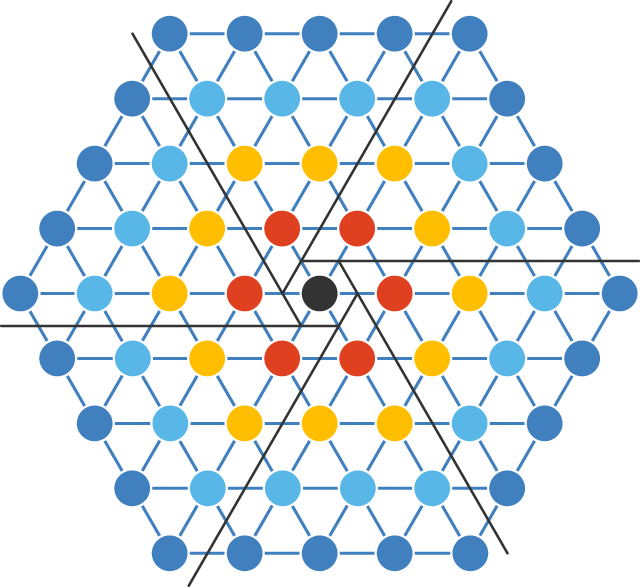A centered hexagonal number, or hex number, is a centered figurate number that represents a hexagon, with an original dot in the center representing the first order hex number, and additional dots added in concentric rings representing successive hex numbers, forming a hexagonal lattice, or packing of circles, depending on your spatial metaphor of choice. In decimal, the first few centered hexagonal numbers are: 1, 7, 19, 37, 61, 91, 127, 169, 217, 271, 331, 397, and so on.
In the above diagram the hex numbers of orders 1 through 5 are shown, with each successive shell of dots added to the previous sum, adding (n – 1) * 6 each time. Since this arrangement can be conceptualized, like all proper hexagons, as a group of six triangles, each hex number n can also be understood as being six times the (n – 1)th triangular number, plus 1 for the center dot (i.e., the first order hex number). Likewise, the numbers can be seen as groups of three "rectangular" rhombi plus the center dot. Again in the above example, the fifth order hex number can be seen as three 4x5 rectangles plus 1, or six 4-triangles plus 1, both of which of course total to 61. (This is reminiscent of the fact that the sum of two consecutive triangular numbers always equals a square number—in this case, adding perhaps a fifth triangular number—15—to one of our fourth triangular number 10s would of course produce the square 25, instead of the merely rectangular 20 we get from combining two of our 4-triangles in this arrangement.)
A further interesting fact about hex numbers is that the sum of the first n hex numbers is equal to the cube of n. For instance, 1+7=2^3=8, 1+7+19=9^3=27, 1+7+19+37=4^3=16, et cetera. To understand this, imagine looking at the corner of a cube, in such a way that the cube looks like a hexagon. Imagine that the cube is actually made up of sub-cubes arranged in the manner of a cubed number. The first cube in the corner can be thought of as the first hex number, which is 1. Below and around this are seven other cubes forming a layer of cubes around the corner cube, which can be thought of as the second hex number, which is in fact 7, and so on. The hex numbers can be thought of as successive "shells" of cubes emanating out from the corner cube. Thus, cubes and hex numbers are merely different figurate ways of describing the same values—the cube of n can be arranged as a pyramid of hex numbers, with a base length of n, and vice versa.
 Hex numbers
Hex numbers